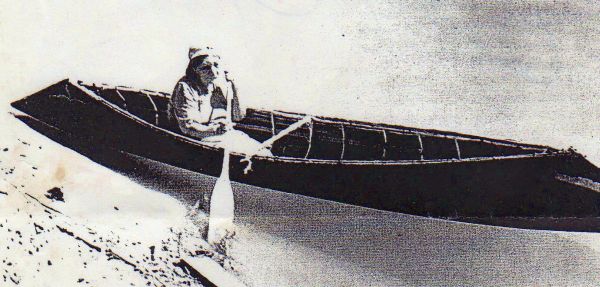Sturgeon Nose Creations
You can own a piece of history, with a model or life-size Sturgeon-Nose Canoe, in your private collection or for your institution.
These are sewn together and sealed with Fir pitch. This is done seasonally, as the materials are available.
Please feel free to browse the History and Construction areas of this website to learn more about this unique craft.
Sturgeon-Nose Canoe
is the Keeper of our Language, our Culture, Heritage, History, and Our Identity.
We traveled the waterways and lakes, from village to village in these white pine bark canoes.
We stored our blankets and utensils in the front of the canoe. The front and back were our trunks. The elders had a procedure when loading the canoe.
I personally, along with my family, grew up in the era where we still customarily used these canoes for harvesting Koot eggs, fishing, and trapping Muskrats.
With our grandmother, Marion Ernst, the elders told me, in the old days it wouldn’t take long to build one. There was a lot of family help. There were plenty of canoes, they were disposable.
Today, the construction of the Sturgeon-Nose Canoe is still alive in Lower Kutenai, with a few families building them. It’s in our blood!
Taxas

Photo courtesy of National Museum of Canada.



Historical Excerpts

A Kutenai Canoe – Frame of white cedar, cover of bark; average length about twelve feet.
Photo courtesy of National Museum of Canada.

I was agreeably surprised, therefore, to find that the Kootenays were a tribe practically untouched by the baneful influences of the aggressive civilisation of the West. They had no reservation; they had no agents over them; they received no assistance from the Government; no official census had ever been taken of them; they lived entirely upon the products of their rivers, lakes, and forests; they spoke a tongue unknown to their next neighbours; they kept strictly to themselves, and, with the exception of their annual buffalo hunt, they never left their own beautiful mountain-girt home.
They were peaceful, and they had been won over to the Roman Catholic religion by missionaries, who have dwelt in their midst since the year 1842. A more unsophisticated and at once attractive race than the Kootenays it would have been difficult to find. (The Kootenays’ independence ended soon after my first visit, when an agent was appointed, and “reserves” given to them. According to the first official census, which was taken a year or two later, the whole tribe numbered about 600 souls.)
The two sub-divisions of the tribe (the Upper and the Lower Kootenays), in consequence of natural features, differed considerably. The home of the former is the country round the Upper Kootenay river, from its source in the very heart of the Rocky Mountains, to where it enters U.S. territory. Here, under the shadow of the towering main chain, this singularly isolated tribe of Indians have lived and thrived.
They were Horse Indians, in distinction to the Canoe Indians, to which the Lower Kootenays or Flatbows belong. And a wonderful playground to run their hardy beasts their mountain-girt home afforded them. Undulating hill-land, with occasional “bunch grass” prairies, fringed by fine forests, make it the very ideal of an Indian country, such as we read of, but, alas! very rarely indeed discover. The Kootenays were a fine, manly-looking race.
– Sport and Life, Baille Grohman, p. 306
The lower Kutenai or more primitive and nomadic, less under the influence of the Catholic church, and more given to gambling. They have long been river and lake Indians, and possess peculiar bark canoes that resemble some of those used in the Amur region in Asia (Mason in Rep. Nat, Mus., 1899).
Religion was a sort of sun worship, and the belief in the ensoulment of all things and in reincarnation prevailed. The land of the dead was in the sun, from which at some time all the departed would descend to lake Pend d’Orielle to meet the Kutenai then living. In the old days the medicine-men were very powerful, their influence surviving most with the Lower Kutenai, who still paint their faces on dance occasions; but tatooing is rare.
Except a sort of reed pipe, a bone flute, and the drum, musical instruments were unknown to them; but they had gambling, dancing, and medicine songs.
The Lower Kutenai were in former days great buffalo hunters. Firearms have driven out the bow and arrow, save as children’s toys or for killing birds. Spearing, the basket trap, and wicker weirs were much in use by the Lower Kutenai.
Besides the bark canoe, they had dugouts; both skin and rush lodges were built; the sweat house was universal. Stone hammers were still in use in parts of their country in the last years of the 19th century.
– Handbook of Indians in Canada, Department of Marine and Fisheries, 2 GeorgeV., A. 1912, Sessional Paper No. 21a, p. 256, 257.

Orders
Pricing
30 inch model – $275
5 foot Canoe – $2500
10 foot Canoe – $5000
Larger sizes – call for pricing
Terms and Payment
50% deposit required in advance
Shipping – normally by pickup, but other options available (Call)
Payment types accepted – Cash, Cheque, Money Order
(we do not accept Credit Card or PayPal at this time)














